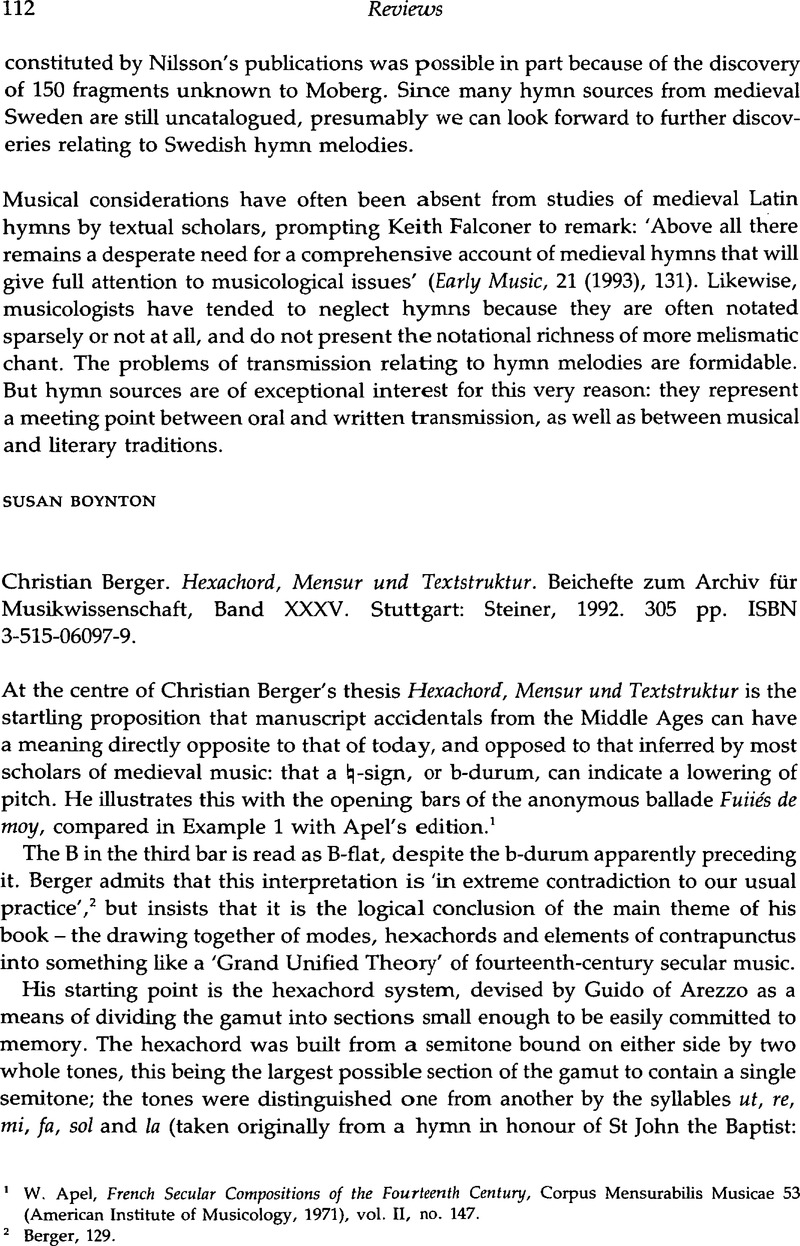No CrossRef data available.
Article contents
Berger. Christian Hexachord, Mensur und Textstruktur. Beichefte zum Archiv für Musikwissenschaft, Band XXXV. Stuttgart: Steiner, 1992. 305 pp. ISBN 3-515-06097-9.
Published online by Cambridge University Press: 12 September 2008
Abstract

- Type
- Reviews
- Information
- Copyright
- Copyright © Cambridge University Press 1994
References
1 Apel, W., French Secular Compositions of the Fourteenth Century, Corpus Mensurabilis Musicae 53 (American Institute of Musicology, 1971), vol. II, no. 147.Google Scholar
2 Berger, 129.
3 Jerome of Moravia explains b-durum as ‘a sign of the fourth tetrachord, by which it is distinguished from the third, that is, b-quadratum must be written differently from b-rotundum’. (Tractatus de musica, ed. Cserba, S. (Regensburg, 1935), 172.)Google Scholar
4 Bent, , ‘Diatonic Ficta’, Early Music History, 4 (1984), 1–48.CrossRefGoogle Scholar
5 Hughes, , Manuscript Accidentals: Ficta in Focus 1350–1450, Musicological Studies and Documents 27 (American Institute of Musicology, 1972).Google Scholar
6 Prosdocimus de′ Beldomandis, for example, wrote: ‘wherever round or soft b is applied, we ought to sing the syllable fa, and wherever square or hard b is applied, we ought to sing the syllable mi, whether or not these syllables are in these places’. (Contrapunctus, ed. Herlinger, J., Greek and Latin Music Theory 1 (Lincoln, NB, 1984), 75.)Google Scholar
7 Musicological Studies and Documents 24 (American Institute of Musicology, 1972).
8 Revue de Musicologie, 66 (1980), 27–56.CrossRefGoogle Scholar
9 Bent, , ‘Musica Recta and Musica Ficta’, Musica Disciplina, 26 (1972), 75.Google Scholar
10 Hughes, Manuscript Accidentals, 9.
11 Berger, 109.
12 Jacques de Liège, Speculum musice (cited by Berger, 104).
13 Hirshberg, , ‘Hexachordal and Modal Structure in Machaut's Polyphonic Chansons’, Studies in Musicology in Honor of Otto E. Albrecht, ed. Hill, J. W. (Kassel, 1980), 19–42.Google Scholar
14 The Berkeley Manuscript, ed. Ellsworth, O., Greek and Latin Music Theory 2 (Lincoln, NB, 1984), 85.Google Scholar
15 Apel, French Secular Compositios, vol. I, p. xxvii.
16 Greene, , French Secular Music, Polyphonic Music of the Fourteenth Century 18 (Monaco, 1981–1982), p. xv.Google Scholar
17 Berger cites only Amerus's, Practica artis musicae of 1271, ed. Ruini, C., Corpus Scriptorum de Musica 25 (American Institute of Musicology, 1977).Google Scholar
18 Berger, 17, citing Planchart's, A. E. review in Journal of Music Theory, 18 (1974), 221.Google Scholar Indeed Berger himself once shared this opinion: he has stated that ‘Unfortunately there is no clear evidence to support Allaire's thesis’. (‘Tonsystem und Textvortrag: Ein Vergleich zweier Balladen des 14. Jahrhunderts’, in Bericht über den internationalen musikwissenschaftlichen Kongress, Stuttgart 1985, ed. Berke, D. and Hanemann, D. (Kassel, 1987), vol. n, 208.)Google Scholar




